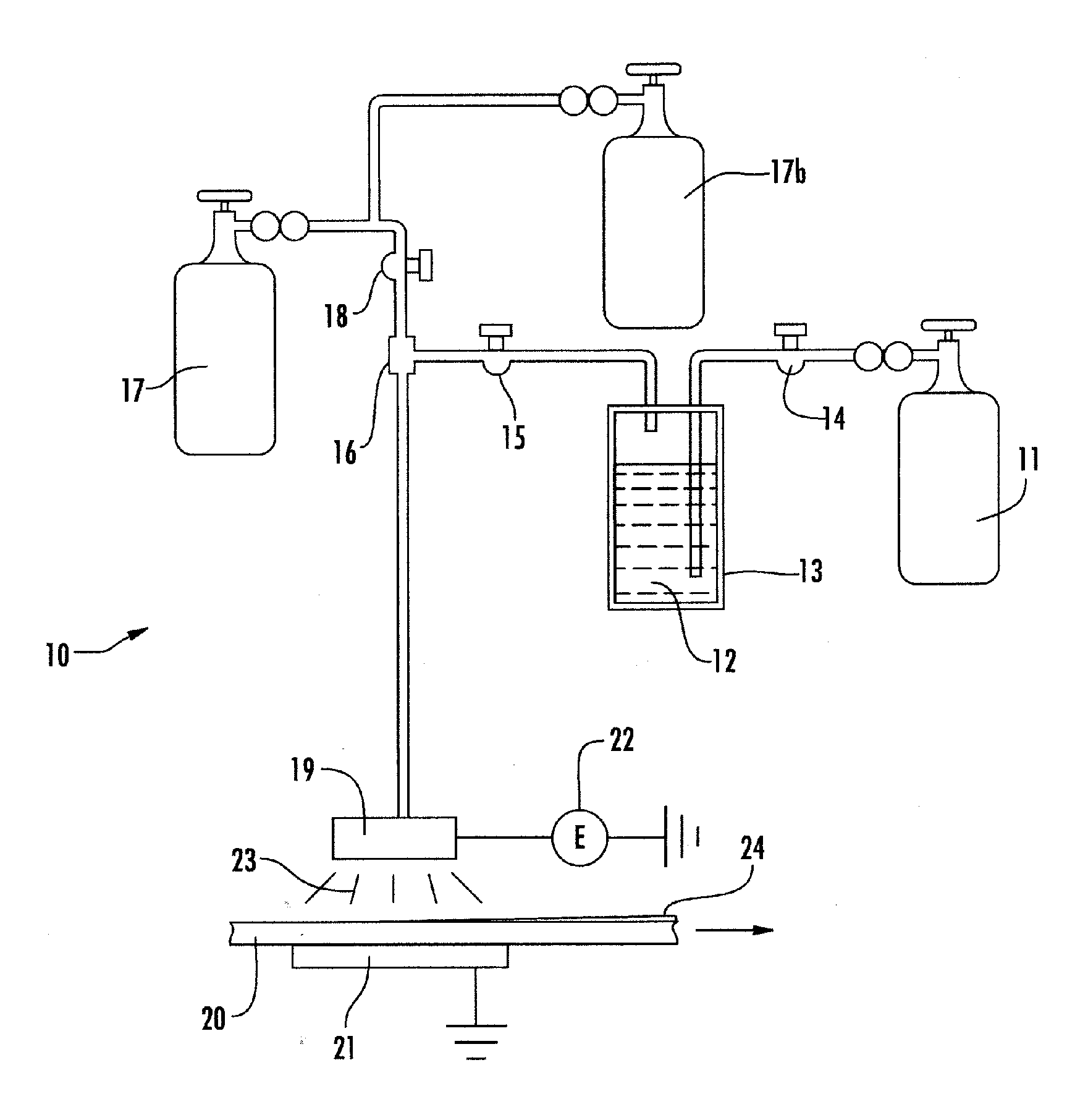Atmospheric pressure plasma enhanced chemical vapor deposition process
- Summary
- Abstract
- Description
- Claims
- Application Information
AI Technical Summary
Benefits of technology
Problems solved by technology
Method used
Image
Examples
example 1
[0021]The apparatus shown in FIG. 1 is assembled. The precursor material 12 is vinyl trimethoxysilane (VTMOS) at a reservoir temperature of 80° C. The carrier gas is helium at 0.75 standard liters per minute. The oxidant gas is oxygen at 6 standard liters per minute, and the ionizing gas is helium at 15 standard liters per minute. The electrical power to the electrode is 1.0 kilowatt (18.8 Watts per square centimeter) centimeter and the electrodes are controlled with 60° C. cooling water. The substrate is one quarter inch thick polycarbonate sheet moving through the plasma at a rate of 2 meters per minute. The deposition rate of the PECVD coating formed on the polycarbonate sheet is 2.1 micrometers per minute. The 1.0 micrometer thick coating is tested using the “Taber Test” (ASTM D3489-85(90)) and found to have a delta haze of 1.1-2.9% after 500 cycles using CS-10F wheels and 500 gram load. This example when compared to the comparative example shows not only the significantly incre...
example 2
[0024]The apparatus shown in FIG. 1 is assembled. The precursor material 12 is vinyl triethoxysilane (VTEOS) at a reservoir temperature of 80° C. The carrier gas is helium at 0.75 standard liters per minute. The oxidant gas is oxygen at 6 standard liters per minute, and the ionizing gas is helium at 15 standard liters per minute. The electrical power to the electrode is 1.0 kilowatt (18.8 Watts per square centimeter) centimeter and the electrodes are controlled with 60° C. cooling water. The substrate is one quarter inch thick polycarbonate sheet moving through the plasma at a rate of 2 meters per minute. The deposition rate of the PECVD coating formed on the polycarbonate sheet is 1.6 micrometers per minute. The coating is not subjected to the quantitative Taber abrasion test, but qualitative testing shows the coating is very hard.
[0025]Fourier transform infrared (FTIR) spectroscopy shows symmetric stretching of Si—O-Si bonds absorbance at 1065 cm−1 indicating a composition that is...
example 3
[0027]The apparatus shown in FIG. 1 is assembled. The precursor material 12 is vinylmethyldimethoxysilane (VMDMOS) at a reservoir temperature of 80° C. The carrier gas is helium at 0.75 standard liters per minute. The oxidant gas is oxygen at 6 standard liters per minute, and the ionizing gas is helium at 15 standard liters per minute. The electrical power to the electrode is 1.0 kilowatt (18.8 Watts per square centimeter) centimeter and the electrodes are controlled with 60° C. cooling water. The substrate is one quarter inch thick polycarbonate sheet moving through the plasma at a rate of 2 meters per minute. The deposition rate of the PECVD coating formed on the polycarbonate sheet is 2.6 micrometers per minute. The coating is not subjected to the quantitative Taber abrasion test, but qualitative testing shows the coating is soft.
[0028]Fourier transform infrared (FTIR) spectroscopy shows symmetric stretching of Si—O-Si bonds absorbance at 1035 cm−1 indicating an organosiloxane co...
PUM
| Property | Measurement | Unit |
|---|---|---|
| Fraction | aaaaa | aaaaa |
| Fraction | aaaaa | aaaaa |
| Fraction | aaaaa | aaaaa |
Abstract
Description
Claims
Application Information
 Login to view more
Login to view more - R&D Engineer
- R&D Manager
- IP Professional
- Industry Leading Data Capabilities
- Powerful AI technology
- Patent DNA Extraction
Browse by: Latest US Patents, China's latest patents, Technical Efficacy Thesaurus, Application Domain, Technology Topic.
© 2024 PatSnap. All rights reserved.Legal|Privacy policy|Modern Slavery Act Transparency Statement|Sitemap



